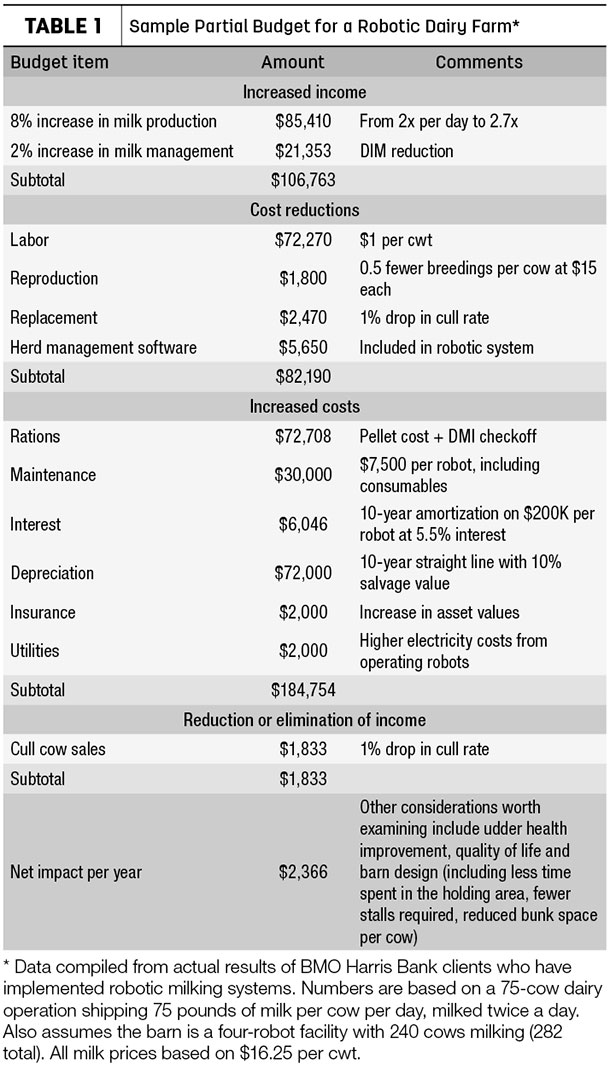A couple of years ago, we had certain assumptions about the cost savings robotic milking systems would yield, and where the bulk of those savings would come from. We expected the main advantages would come from reduced labor costs and increased milk production. But has that turned out to be the case? What’s changed in the last two years?
In 2016, the average cost for a dairy robot was about $200,000. Based on discussions we had with dairy operators in the Upper Midwest, we estimated producers could expect robots to pay for themselves after seven years.
Today, the cost for a robotic milking system is about the same. We’ve found that for a new milking facility, four robots each milking 60 cows per day will provide maximum efficiency. Though some farms can squeeze a bit more per-cow yield from a robot, most operations don’t experience any increase in milk production after the 60-cow threshold. So if you’re constructing a new robotic milking facility, you’re looking at an investment of about $1.4 million to $1.6 million to build the barn (depending on whether you include manure storage and bunkers) and around $800,000 for the four robots.
That’s a hefty investment, but the assumption was reduced labor costs would offset it over time. Those estimates were based on an expectation of a $1.50 per hundredweight (cwt) savings in labor costs. After reviewing the data from our clients who have implemented robots over the past couple of years, we’re seeing an actual labor savings of about 75 cents to $1 per cwt. So, why haven’t the savings been as dramatic?
Still hiring
While the initial thinking was that the technology would allow operators to eliminate certain positions, it turns out that there’s still plenty of work to do in the barn. Tasks such as robot maintenance take time away from typical dairy management duties. That means operators are bringing in part-time workers to handle traditional duties such as feeding and cleanup. In the end, we’ve noticed that operators still require the same amount of labor. Also, the type of labor has changed. When you transition from a stanchion barn to a robotic system, time that was once spent milking cows is now spent on managing the robots.
Adopting robotic milking systems was seen as a case of trading labor for capital. But if you’re not getting as much bang for your buck on the labor savings, then what is the payback? Is it increased milk production? Higher premiums because of consistent quality?
The technology certainly has made many operators better managers. Robots have taken a lot of management-level operations to a higher level, providing a wealth of data – production variables, milk quality and general cow health, including heat detection and rumination time – that help operators make more accurate management decisions and improve efficiency. Some robotic systems can also connect with external herd management systems.
Changing calculations
If you’re relying on labor savings to pay for the capital costs, your investment needs to be based on a 10-year amortization, not a seven-year amortization as initially thought. Of course, many farms can’t support a 10-year amortization based on their cash flow. Also, technology is changing so quickly that the real depreciation may occur before repayment. That means on a 10-year repayment for robots, you might have to reinvest in upgrades, depending on what you want your robots to accomplish.
Alternatively, leasing provides 100 percent financing while allowing you to maintain access to capital. In some cases, you can find leasing payments based on a seven-year amortization with a residual value purchase option in year six, when the operator has the opportunity to purchase the robots outright from the equipment finance company.
Even if the labor savings aren’t living up to initial expectations, the long-term benefits of dairy robots are still attractive. But in an environment where margins are squeezed tighter and tighter, borrowing your last dollar to adopt robotics may not be a wise choice for your operation.
That’s why when deciding whether to adopt robotic milking, completing a partial budget may be a wise investment of your time, as it gives you the opportunity to review the financial impact of implementing the technology (see Table 1). One factor that gets left out in this calculation, however, is the impact of borrowing on your balance sheet. Completing a projected balance sheet after a hypothetical implementation will demonstrate whether you’re able to maintain an adequate cushion (liquidity and core equity) to sustain the operation through market volatility.
In the end, it’s a matter of balancing the desire to improve efficiency in the long term with maintaining access to capital. For many operators, it’s making sure your calculations indicate you can achieve that balance through improved efficiencies, whether that’s due to better management, increased milk production or improved milk quality. ![]()
For more agriculture industry insights, visit the BMO Harris Bank website.

-
Craig Rogan
- Vice President of Business Banking
- BMO Harris Bank
- Email Craig Rogan

-
Brad Guse
- Senior Vice President of Agricultural Banking
- BMO Harris Bank
- Email Brad Guse
PHOTO: Staff photo.







